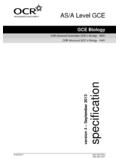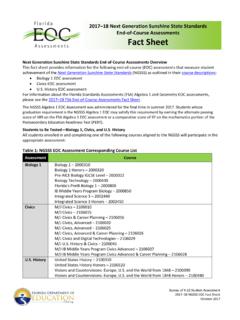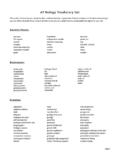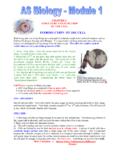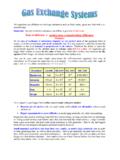Transcription of A-level Biology Specimen question paper Paper 1
1 Specimen MATERIAL Specimen 2014 Session Time allowed: 2 hours Materials For this Paper you must have: a ruler with millimetre measurements a calculator. Instructions Use black ink or black ball-point pen. Fill in the boxes at the bottom of this page. Answer all questions. Information The marks for questions are shown in brackets. The maximum mark for this Paper is 91. A-level Biology (7402/1) Paper 1 Please write clearly, in block capitals, to allow character computer recognition. Centre number Candidate number Surname Forename(s) Candidate signature 2 Answer all questions in the spaces provided. A technician investigated the effect of temperature on the rate of an enzyme-controlled reaction. At each temperature, he started the reaction using the same concentration of substrate. Figure 1 shows his results. Give two other factors the technician would have controlled.
2 [1 mark] Draw a tangent on each curve to find the initial rates of reaction. Use these values to calculate the ratio of the initial rates of reaction at 60 C : 37 C. Show your working. [2 marks] 0 1 . 2 0 1 . 1 1 2 Ratio = :1 1 3 Turn over Explain the difference in the initial rate of reaction at 60 C and 37 C. [2 marks] Explain the difference in the rates of reaction at 60 C and 37 C between 20 and 40 minutes. [4 marks] 0 1 . 3 0 1 . 4 [Extra space] 4 Describe how oxygen in the air reaches capillaries surrounding alveoli in the lungs. Details of breathing are not required. [4 marks] Forced expiratory volume (FEV) is the greatest volume of air a person can breathe out in 1 second. Forced vital capacity (FVC) is the greatest volume of air a person can breathe out in a single breath.
3 Figure 2 shows results for the volume of air breathed out by three groups of people, A, B and C. Group A had healthy lungs. Groups B and C had different lung conditions that affect breathing. 0 2 . 1 [Extra space] 5 Turn over Calculate the percentage drop in FEV for group C compared with the healthy people. [1 mark] Asthma affects bronchioles and reduces flow of air in and out of the lungs. Fibrosis does not affect bronchioles; it reduces the volume of the lungs. Which group, B or C, was the one containing people with fibrosis of their lungs? Use the information provided and evidence from Figure 2 to explain your answer. [3 marks] 0 2 . 2 0 2 . 3 [Extra space] Answer = 6 Species richness and an index of diversity can be used to measure biodiversity within a community. What is the difference between these two measures of biodiversity? [1 mark] Scientists investigated the biodiversity of butterflies in a rainforest.
4 Their investigation lasted several months. The scientists set one canopy trap and one understorey trap at five sites. The canopy traps were set among the leaves of the trees 16 27 m above ground level. The understorey traps were set under trees at m above ground level. The scientists recorded the number of each species of butterfly caught in the traps. Table 1 summarises their results. Table 1 Species of butterfly Mean number of butterflies P value In canopy In understorey Prepona laertes 15 0 < Archaeoprepona demophon 14 37 < Zaretis itys 25 11 > Memphis arachne 89 23 < Memphis offa 21 3 < Memphis xenocles 32 8 < The traps in the canopy were set at 16 27 m above ground level. Suggest why there was such great variation in the height of the traps. [1 mark] 0 3 . 1 0 3 . 2 3 7 Turn over By how many times is the species diversity in the canopy greater than in the understorey?
5 Show your working. Use the following formula to calculate species diversity. = ( 1) ( 1) where is the total number of organisms of all species and is the total number of organisms of each species. [3 marks] The scientists carried out a statistical test to see if the difference in the distribution of each species between the canopy and understorey was due to chance. The P values obtained are shown in Table 1. Explain what the results of these statistical tests show. [3 marks] 0 3 . 3 0 3 . 4 Answer = [Extra space] 8 Starch and cellulose are two important plant polysaccharides. Figure 3 shows part of a starch molecule and part of a cellulose molecule. Explain the difference in the structure of the starch molecule and the cellulose molecule shown in Figure 3. [2 marks] Starch molecules and cellulose molecules have different functions in plant cells.
6 Each molecule is adapted for its function. Explain one way in which starch molecules are adapted for their function in plant cells. [2 marks] 0 4 . 1 0 4 . 2 4 9 Turn over Explain how cellulose molecules are adapted for their function in plant cells. [3 marks] Turn over for the next question 0 4 . 3 [Extra space] 10 Contrast the processes of facilitated diffusion and active transport. [3 marks] Students investigated the uptake of chloride ions in barley plants. They divided the plants into two groups and placed their roots in solutions containing radioactive chloride ions. Group A plants had a substance that inhibited respiration added to the solution. Group B plants did not have the substance added to the solution. The students calculated the total amount of chloride ions absorbed by the plants every 15 minutes.
7 Their results are shown in Figure 4. 0 5 . 1 [Extra space] 11 Turn over Calculate the ratio of the mean rate of uptake of chloride ions in the first hour to the rate of uptake of chloride ions in the second hour for group B plants. [2 marks] Explain the results shown in Figure 4. [4 marks] 0 5 . 2 0 5 . 3 [Extra space] Ratio = :1 12 Table 2 shows how a bird called the bluethroat (Luscinia svecica) is classified by biologists. Table 2 Taxon Name of taxon Domain Eukaryota Animalia Chordata Aves Passeriformes Muscicapidae Genus Species Complete Table 2 by filling the seven blank spaces with the correct terms. [2 marks] A group of scientists investigated genetic diversity in different species of bird. For each species, the scientists: collected feathers from a large number of birds extracted DNA from cells attached to each feather analysed the samples of DNA to find genetic diversity.
8 Table 3 summarises their results. Table 3 Species of bird Number of genes examined Number of genes examined that showed genetic diversity Willow flycatcher 708 197 House finch 269 80 Bluethroat 232 81 0 6 . 1 6 13 Turn over In this investigation, what is meant by genetic diversity? [1 mark] The scientists concluded that the bluethroat showed greater genetic diversity than the willow flycatcher. Explain why they reached this conclusion. Use calculations to support your answer. [2 marks] Turn over for the next question 0 6 . 3 0 6 . 2 14 Figure 5 shows a test that has been developed to find out if a person has antibodies to the human immunodeficiency virus (HIV) antigen. Figure 5 This test only detects the presence of HIV antibodies.
9 Give two reasons why it cannot be used to find out if a person has AIDS. [2 marks] 0 7 . 1 HIV antigens are attached to a test well in a dish. A sample of blood plasma is added to the well. If HIV antibodies are present, they bind to the HIV antigen. The well is washed. A second antibody with an enzyme attached is then added. This binds specifically to the HIV antibody. The well is washed again. A yellow solution is added, which changes to blue if the enzyme is present. A blue colour shows that the person has HIV antibodies. Step 1 Step 2 Step 3 Step 4 7 1 2 15 Turn over The solution will remain yellow if a person is not infected with HIV. Explain why. [2 marks] A mother who was infected with HIV gave birth to a baby. The baby tested positive using this test. This does not prove the baby is infected with HIV. Explain why. [2 marks] A control well is set up every time this test is used.
10 This is treated in exactly the same way as the test wells, except that blood plasma is replaced by a salt solution. Use information from Figure 5 to suggest two purposes of the control well. [2 marks] 0 7 . 2 0 7 . 3 0 7 . 4 1 2 16 Figure 6 represents part of a DNA molecule. Draw a box around a single nucleotide. [1 mark] Table 4 shows the percentage of bases in each of the strands of a DNA molecule. Table 4 DNA strand Percentage of each base A C G T Strand 1 16 Strand 2 21 34 Complete Table 4 by adding the missing values. [2 marks] 8 0 8 . 1 0 8 . 2 17 Turn over During replication, the two DNA strands separate and each acts as a template for the production of a new strand. As new DNA strands are produced, nucleotides can only be added in the 5 to 3 direction. Use Figure 6 and your knowledge of enzyme action and DNA replication to explain why new nucleotides can only be added in a 5 to 3 direction.











